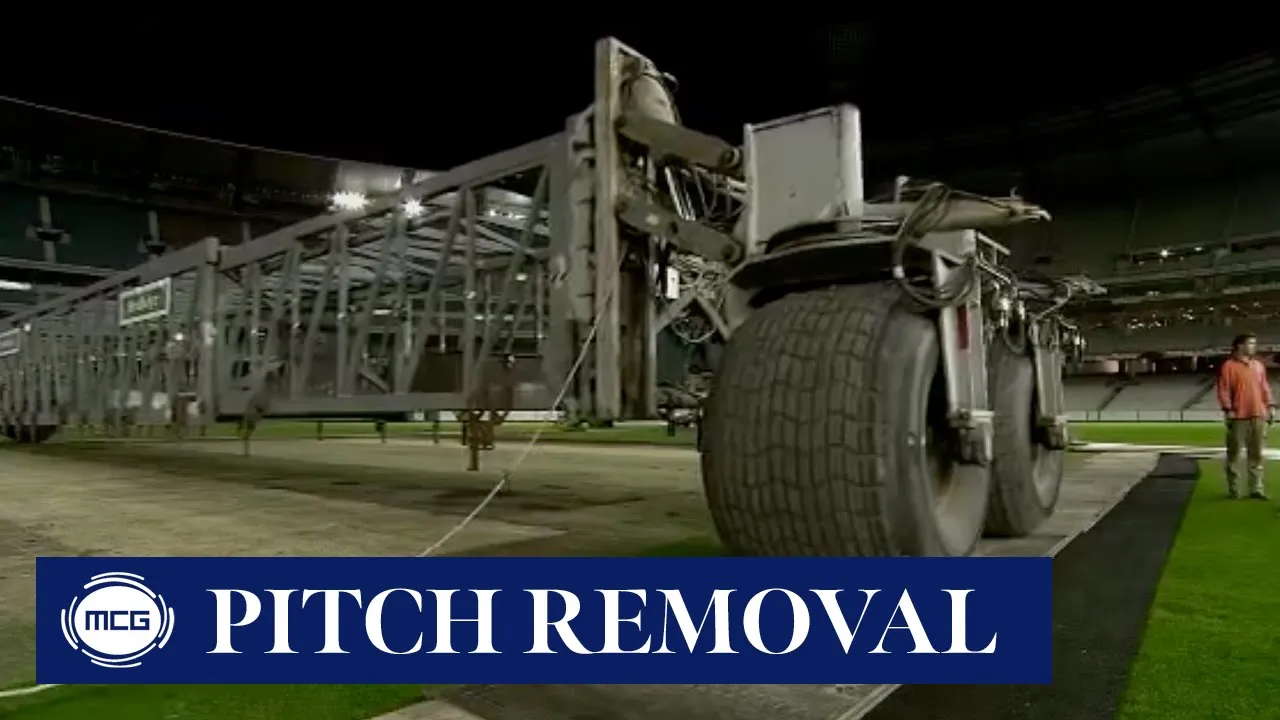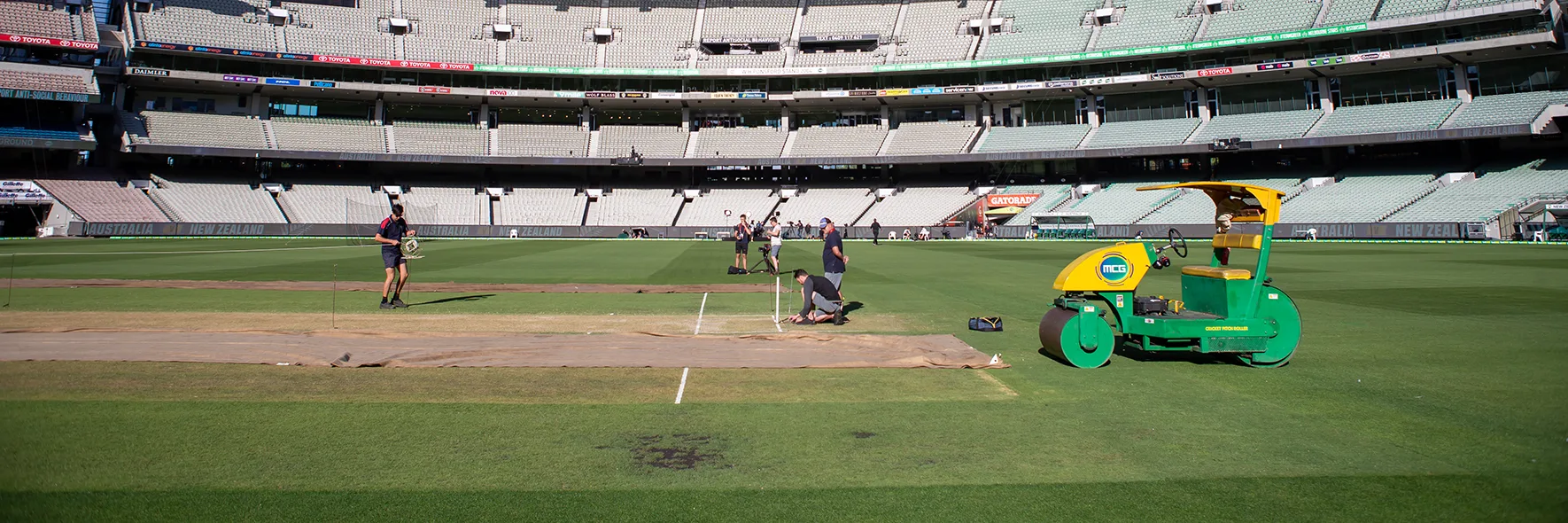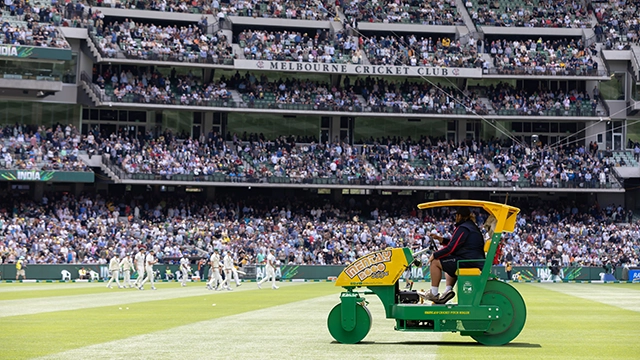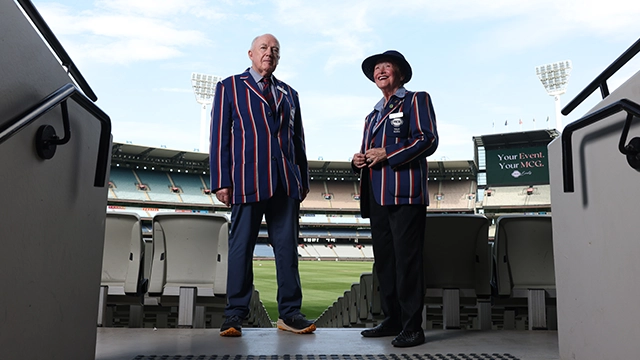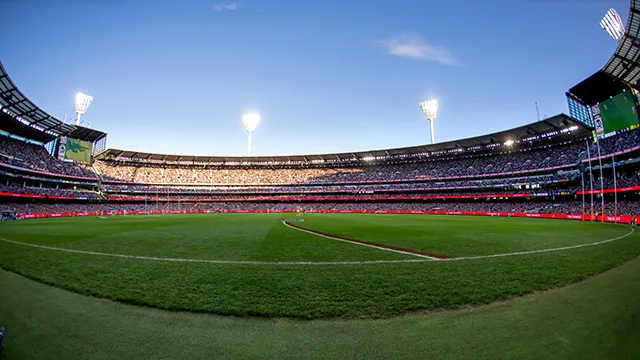How It Works
By ‘dropping in’ the cricket pitches with huge cranes and taking them out at the end of the cricket season, it gave the arena greater flexibility to host events throughout the year.
Here’s how the first pitch was installed back in 1996:
- A bed was excavated on the edge of the wicket table, fine screenings laid and laser levelled.
- The 16-tonne half pitch arrived with lifting frame attached.
- A fine mesh ‘wrap’, secured by tiny wooden pegs, helped keep the 35cm-deep black soil slab intact.
- Arena damage by heavy equipment was minimised by using heavy plywood squares to spread the load.
- A porous sheet is laid to prevent contamination of the wicket slab by screenings and other material below. The pitch is lifted into position.
- The lifting frame was simply but ingeniously attached to the slab by steel rods threaded through the eyelets of heavy gauge corkscrews embedded in the pitch, employing the same principle as wine bottle openers.
- With the slab in position, the rods were removed and the frame lifted off.
- The final task was removal of about 500 corkscrews from the wicket. Surface markings disappeared after the first roll.
By 1998 the process had been refined to a point where Arenas manager Tony Ware felt that if players hadn’t previously been told, they wouldn’t have known a portable pitch had been used for the match.
Tony and his team developed a load-bearing roadway system to allow even the biggest trucks and cranes to come onto the ground with minimal damage to the playing surface.
A portable pitch production centre was established outside the Ponsford Stand. While the football season was played, six pitches were nurtured for the following summer. They are laid on a concrete slab and provided excellent tracks for installation as required during the cricket season.
The new wicket area covers 700 square metres and sits on a giant concrete rectangle. At 28 metres in width, it is only slightly narrower than the traditional wicket table, which was 30 metres wide.
The key benefit from the new technology is that it allows for more mature grass and root systems to develop, untouched by sand or other debris from the football season.
As Cricket Australia chief executive James Sutherland noted: “The advent of the portable pitches has helped us make the cricket calendar more flexible and innovative and provide more opportunities for fans to see the Australian team play live.”
Technology Pioneered at the MCG
The MCG is one of Australia’s greatest assets. It is also one of Australia’s biggest and most popular stadiums and an extremely busy venue accommodating cricket, Australian football, rugby, soccer, concerts and other major functions on its natural turf arena.
The volume and variety of events played at the MCG requires a versatile surface that enables the stadium to switch from one sport to another in a short period of time.
The MCG has developed perhaps one of the finest turf maintenance systems in the world. It has led the field in a range of turf management techniques designed to develop a playing surface which can be used efficiently and meets competition demands.
The 1992 reconstruction of the oval utilising a revolutionary sand-based profile boosted drainage capacity and introduced a more durable turf cover so that more events could be scheduled at the MCG.
More recently, however, the MCG pioneered the world’s first successful portable cricket pitch technology, involving a lightweight steel frame, pitch construction method and installation machinery that makes the installation, removal and performance of the portable pitch system workable.
The revolutionary system, which involves growing and nurturing cricket pitches off-site and “dropping” them into the centre of the arena at the start of the cricket season, enabled the MCG to produce a FIFA-standard soccer pitch for Olympic football at the ground just 10 days after the 2000 AFL Grand Final.
The absence of cricket pitches from the centre in the winter months provides a safer playing surface for AFL players and allows events such as international soccer and Bledisloe Cup rugby to be played on a world-class surface.
An example of this flexibility came in December 1999 when an AFL exhibition match between Carlton and Collingwood was staged just 24 hours after the conclusion of the Boxing Day Test.
The new wicket area covers 700 square metres and sits on a giant concrete rectangle. At 28 metres in width, it is only slightly narrower than the traditional wicket table, which was 30 metres wide.
The key benefit from the new technology is that it allows for more mature grass and root systems to develop, untouched by sand or other debris from the football season.
2011: How do we remove the portable cricket wickets, and where do they go?
